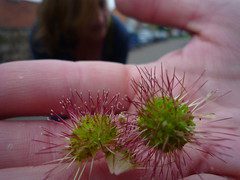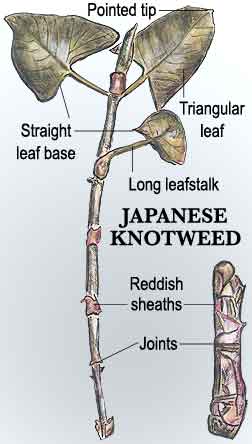I’m looking at the relationship between invasive species and their causes.
Taking a rather primitive approach, I want to offer up this solution: Eat Thy Enemy.
Many promise to be delicious–
1. Japanese Knotweed (Polygonum cuspidatum, Fallopia japonica)
Invaded: 1850’s. Imported from Japan as ornamental
“tastes like rhubarb, only better” – Steve Brill
Fantastic information on knotweed on Wildman Steve Brill‘s site.
Euell Gibbons’ “Stalking the Wild Asparagus” wrote that Japanese knotweed tasted like rhubarb and was good eats — apparently you could make pie, jam and even a tasty soup with it.
Back home, I peeled the bottoms of the foot-long stalks, removed its leaves, and sampled my polygonum notch-by-notch. Japanese knotweed is crisp and surprisingly tart raw, rather like an immature Granny Smith crossed with a tomatillo. Parboiled, the tips have asparagus-like first notes, followed quickly by a tart, high-in-Vitamin-C-punch — there’s a reason why it’s often compared to rhubarb.Some recommend steaming it as a side dish or adding it raw to salads. I added it to tomatoes, cilantro, shallots, habanero pepper, and lime for a twist on salsa fresca. (from The Stoop, Ava Chin’s New York Times’ blog
Plants for a Future rates this plant rather well – although warns about photosensitivity from knoteweed’s oxalic acid content (same as rhubarb or sorrel).
***
2. Pennywort (Hydrocotyle ranunculoides, Centella asiatica)* a.k.a. gotu kola
Invaded: 1980’s. Introduced commercially for use in garden ponds and aquaria
Stem, leaves and roots are edible. Used in salads, drinks, rice dishes, raita in Asia. Has health benefits attributed to it. (from Practically Edible)
Big glowing dissertation on its gustatory and salutory properties: Pennywort: The Elixir of Life
***
3.Hottentot Fig (Carpobrotus edulis)
Invaded: 1886. Introduced from South Africa to stabilize soil and dunes
The creeping, smothering mats of Hottentot Fig out-compete native plants and reduce biodiversity by competing for nutrients, water, space and light. It is a plant of coastal habitats and as such threatens some of the most sensitive ecology in the UK.
On the upside, it has edible fruits, although sour can be made into jams. Not invasive (yet) in the north; mostly restricted to Devon/Cornwall area (NNSS)
Fruit – raw, cooked, dried for later use or made into pickles, chutney etc. There is very little flesh in the fruit and it must be fully ripe otherwise it is very astringent. Mucilaginous and sweetly acid. Leaves – raw or cooked. Succulent, they are eaten in salads and can also be used as a substitute for pickled cucumber. We find them too mucilaginous to be enjoyable. (Plants for a Future)
***
4. Common Water Hyacinth (Eichhornia crassipes)
origin: South America. Invasion date unknown
The plant is used as a carotene-rich table vegetable in Taiwan. Javanese sometimes cook and eat the green parts and inflorescence. (Duke, Handbook of Energy Crops) (also mentions that “eating the plant may induce itching,” but perhaps only if raw?)
***
5. Himalayan Balsam (Impatiens glandulifera) a.k.a. Jewelweed
Invasion: 1839. Western Himalayas.
Himalayan Balsam has been eaten in India for hundreds of years…the seeds are eaten, having a nutty flavour, while the young leaves are used as a vegetable.(from Eat Weeds UK)
Young leaves and shoots – cooked… Seed – raw. A delicious nutty flavour, but difficult to harvest in quantity mainly because of their exploding seed capsules which scatter the ripe seed at the slightest touch. An edible oil is obtained from the seed.The plant is used in Bach flower remedies – the keywords for prescribing it are ‘Impatience’, ‘Irritability’ and ‘Extreme mental tension’. It is also one of the five ingredients in the ‘Rescue remedy.’ (Plants for a Future)

***
6. Wakame (Undaria pinnatifida)
(currently not a threat in Northumberland)
This is delicious in soups, tsunomono (vinegared seafood), etc. Commonly used in Japanese cooking. High in antioxidants and vitamins.
***
7. Dead Man’s Fingers or Green Sea Fingers (Codium fragile subsp. tomentosoides)
Invaded: stats from plantlife.org.uk
I suspect it is edible, but need confirmation.
***
8. Pirri-pirri bur (Acaenia anserinifolia) a.k.a. bidgee-widgee
Invaded: Native to New Zealand. Suspected import in “contaminated” wool.
Sticks to you like sculptural velcro and breaks apart easily. Has made significant inroads on Holy Island and in norther Ireland.
It’s in the Rosaceae family; and according to Plants for a Future, the leaves can be used for tea and are Antiphlogistic; Diuretic; and Vulnerary. (Plants for the Future)

***
9. Wireweed (Sargassum muticum) a.k.a. japweed
Invaded: TBD
Another lovely addition to salads, having little exploding flavours when eaten. Cooked with fish, scallops, made for each other. (foods wild)
***
10. Water Chestnut (Trapa natans)
Invaded: TBD
note: Must be cooked before eating, the seed/fruit contain a toxin that is destroyed by cooking.

..floating annual aquatic plant, growing in slow-moving water up to 5 meters deep, native to warm temperate parts of Eurasia and Africa. They bear ornately shaped fruits that resemble the head of a bull, each containing a single very large starchy seed. It has been cultivated in China for at least 3,000 years for these seeds, which are boiled and sold as an occasional streetside snack in the south of that country.(wikipedia)
Singhara Flour / Water Chestnut Powder:
StarchWater Chestnut Flour is made from dried, ground water chestnuts. The nuts are boiled, peeled, dried then ground into flour.
The flour, which is actually a starch rather than a flour, is bright white fine powder.
It’s primary use is as a thickener. It is also used in Asian recipes to make batters for deep-frying.Water Chestnut Flour gives a light crust when used for dredging, and stays white as a coating even when fried.
It is very different from “real” chestnut flour, which is sweet.
Cooking Tips: Mix with water first before adding to hot liquid as a thickener. (practically edible)Singhara is Indian water-chestnut, triangular in shape, with thick red…ish green skin, with 2 small spikes at the top. It has milky white, lightly sweet flesh. It is eaten like a fruit when fresh, made into bhajies and curries when halfway mature and made into flour when completely mature and dry.
Recipe for Singhara Flour Halva
You can also make Singhara poori.
***
